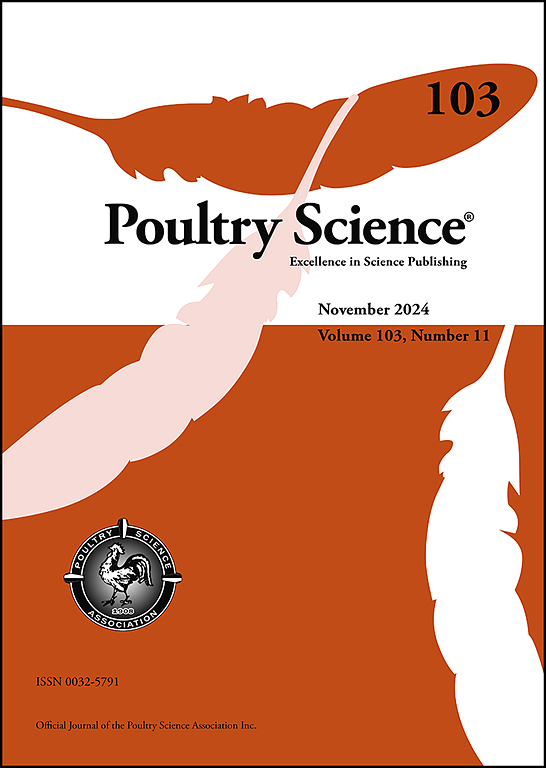整合16S rRNA和宏基因组测序揭示了鸭肠道菌群中关键抗生素耐药基因的分布
IF 3.8
1区 农林科学
Q1 AGRICULTURE, DAIRY & ANIMAL SCIENCE
引用次数: 0
摘要
鸭肠道菌群对宿主健康至关重要,被认为是抗生素耐药基因(ARGs)的潜在储存库。然而,对鸭肠道菌群中ARGs的研究有限。本研究从两种饲养条件(有或无露天游泳池)下饲养的鸭子的五个肠段(十二指肠、空肠、回肠、盲肠和结直肠)中采集了120份肠道内容物样本。我们编制了鸭肠道微生物基因的全面清单,并利用16S rRNA基因测序结合宏基因组学对鸭肠道各部分微生物组成和功能进行了分析。结果表明,厚壁菌门是所有肠道段中最普遍的微生物。在前肠(十二指肠、空肠和回肠),微生物功能主要与转录、翻译、复制和糖合成/糖异生等遗传信息处理有关。相反,在后肠(盲肠和结直肠)中,微生物功能主要与次生代谢物的生物合成和各种代谢途径相关。ARGs分析显示,盲肠和结直肠中ARGs的相对丰度较高(P <;有露天游泳池的鸭子的死亡率比没有露天游泳池的鸭子高0.05)。此外,通过共现网络分析,我们发现Bacteroides、Roseburia、Ruminococcus和Blautia是后肠中tetQ、tet32、tet37、vanR、vanG和acrB等ARGs的潜在宿主。本研究为鸭肠道中ARGs与微生物群落之间的复杂关系提供了新的认识,为了解ARGs在这些生态系统中的传播动态奠定了理论基础。本文章由计算机程序翻译,如有差异,请以英文原文为准。
Integrated 16S rRNA and metagenomic sequencing reveals the distribution of key antibiotic resistance genes in duck gut microbiota
The duck gut microbiota is essential for host health and is considered a potential reservoir for antibiotic resistance genes (ARGs). However, research on ARGs in the duck gut microbiota is limited. This study collected 120 intestinal content samples from five segments (duodenum, jejunum, ileum, cecum, and colorectum) of ducks raised under two rearing conditions (with or without an open-air swimming pool). We compiled a comprehensive inventory of microbial genes in the duck gut and conducted an analysis of microbial composition and function across all intestinal segments using 16S rRNA gene sequencing combined with metagenomics. The findings revealed that Firmicutes were the most prevalent microbes in all intestinal segments. In the foregut (duodenum, jejunum, and ileum), microbial functions were mainly related to genetic information processing such as transcription, translation, replication, and glycosynthesis/gluconeogenesis. Conversely, in the hindgut (cecum and colorectum), microbial functions were primarily associated with the biosynthesis of secondary metabolites and various metabolic pathways. The analysis of ARGs indicated a higher relative abundance of ARGs in the cecum and colorectum (P < 0.05) of ducks in the presence of an open-air swimming pool compared to the absence of one. Furthermore, through co-occurrence network analysis, we identified Bacteroides, Roseburia, Ruminococcus, and Blautia as potential hosts of ARGs such as tetQ, tet32, tet37, vanR, vanG, and acrB in the hindgut. This study provides new insights into the complex relationship between ARGs and the microbial community in duck intestines, laying a theoretical groundwork for understanding the transmission dynamics of ARGs in these ecosystems.
求助全文
通过发布文献求助,成功后即可免费获取论文全文。
去求助
来源期刊

Poultry Science
农林科学-奶制品与动物科学
CiteScore
7.60
自引率
15.90%
发文量
0
审稿时长
94 days
期刊介绍:
First self-published in 1921, Poultry Science is an internationally renowned monthly journal, known as the authoritative source for a broad range of poultry information and high-caliber research. The journal plays a pivotal role in the dissemination of preeminent poultry-related knowledge across all disciplines. As of January 2020, Poultry Science will become an Open Access journal with no subscription charges, meaning authors who publish here can make their research immediately, permanently, and freely accessible worldwide while retaining copyright to their work. Papers submitted for publication after October 1, 2019 will be published as Open Access papers.
An international journal, Poultry Science publishes original papers, research notes, symposium papers, and reviews of basic science as applied to poultry. This authoritative source of poultry information is consistently ranked by ISI Impact Factor as one of the top 10 agriculture, dairy and animal science journals to deliver high-caliber research. Currently it is the highest-ranked (by Impact Factor and Eigenfactor) journal dedicated to publishing poultry research. Subject areas include breeding, genetics, education, production, management, environment, health, behavior, welfare, immunology, molecular biology, metabolism, nutrition, physiology, reproduction, processing, and products.
 求助内容:
求助内容: 应助结果提醒方式:
应助结果提醒方式:


